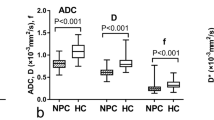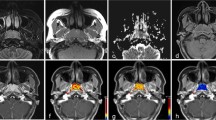Abstract
Objectives
MRI can detect early-stage nasopharyngeal carcinoma (NPC), but the detection is more challenging in early-stage NPCs because they must be distinguished from benign hyperplasia in the nasopharynx. This study aimed to determine whether intravoxel incoherent motion diffusion-weighted imaging (IVIM DWI) MRI could distinguish between these two entities.
Methods
Thirty-four subjects with early-stage NPC and 30 subjects with benign hyperplasia prospectively underwent IVIM DWI. The mean pure diffusion coefficient (D), pseudo-diffusion coefficient (D*), perfusion fraction (f) and apparent diffusion coefficient (ADC) values were calculated for all subjects and compared between the 2 groups using Student’s t test. Receiver operating characteristics with the area under the curve (AUC) was used to identify the optimal threshold for all significant parameters, and the corresponding diagnostic performance was calculated. A p value of < 0.05 was considered statistically significant.
Results
Compared with benign hyperplasia, early-stage NPC exhibited a significantly lower D mean (0.64 ± 0.06 vs 0.87 ± 0.11 × 10−3 mm2/s), ADC0–1000 mean (0.77 ± 0.08 vs 1.00 ± 0.13 × 10−3 mm2/s), ADC300–1000 (0.63 ± 0.05 vs 0.86 ± 0.10 × 10−3 mm2/s) and a higher D* mean (32.66 ± 4.79 vs 21.96 ± 5.21 × 10−3 mm2/s) (all p < 0.001). No significant difference in the f mean was observed between the two groups (p = 0.216). The D and ADC300–1000 mean had the highest AUC of 0.985 and 0.988, respectively, and the D mean of < 0.75 × 10−3 mm2/s yielded the highest sensitivity, specificity and accuracy (100%, 93.3% and 96.9%, respectively) in distinguishing early-stage NPC from benign hyperplasia.
Conclusion
DWI has potential to distinguish early-stage NPC from benign hyperplasia and D and ADC300–1000 mean were the most promising parameters.
Key Points
• Diffusion-weighted imaging has potential to distinguish early-stage nasopharyngeal carcinoma from benign hyperplasia in the nasopharynx.
• The pure diffusion coefficient, pseudo-diffusion coefficient from intravoxel incoherent motion model and apparent diffusion coefficient from conventional diffusion-weighted imaging were significant parameters for distinguishing these two entities in the nasopharynx.
• The pure diffusion coefficient, followed by apparent diffusion coefficient, may be the most promising parameters to be used in screening studies to help detect early-stage nasopharyngeal carcinoma.



Similar content being viewed by others
Abbreviations
- ADC:
-
Apparent diffusion coefficient
- AUC:
-
Area under the curve
- CI:
-
Confidence interval
- D :
-
Pure diffusion coefficient
- D*:
-
Pseudo-diffusion coefficient
- DWI:
-
Diffusion-weighted imaging
- EBV:
-
Epstein–Barr virus
- f :
-
Perfusion volume fraction
- ICC:
-
Intra-class correlation coefficient
- IVIM:
-
Intravoxel incoherent motion
- NPC:
-
Nasopharyngeal carcinoma
References
Bhatia KSS, King AD, Vlantis AC et al (2012) Nasopharyngeal mucosa and adenoids: appearance at MR imaging. Radiology 263:437–443
Chan KCA, Woo JKS, King A et al (2017) Analysis of plasma Epstein–Barr virus DNA to screen for nasopharyngeal Cancer. N Engl J Med 377:513–522
King AD, Vlantis AC, Bhatia KSS et al (2011) Primary nasopharyngeal carcinoma : diagnostic accuracy of MR imaging versus that of endoscopy and endoscopic biopsy. Radiology 258:531–537
King AD, Wong LYS, Law BKH et al (2018) MR imaging criteria for the detection of nasopharyngeal carcinoma: discrimination of early-stage primary tumors from benign hyperplasia. AJNR Am J Neuroradiol 39:515–523
Thoeny HC, De Keyzer F, King AD (2012) Diffusion-weighted MR imaging in the head and neck. Radiology 263:19–32
Zhang SX, Jia QJ, Zhang ZP et al (2014) Intravoxel incoherent motion MRI: emerging applications for nasopharyngeal carcinoma at the primary site. Eur Radiol 24:1998–2004
Le Bihan D, Breton E, Lallemand D et al (1988) Separation of diffusion and perfusion in intravoxel incoherent motion MR imaging. Radiology 168:497–505
King AD, Lam WWM, Leung SF et al (1999) MRI of local disease in nasopharyngeal carcinoma: tumour extent vs tumour stage. Br J Radiol 72:734–741
King AD, Bhatia KSS (2010) Magnetic resonance imaging staging of nasopharyngeal carcinoma in the head and neck. World J Radiol 2:159
King AD, Vlantis AC, Yuen TWC et al (2015) Detection of nasopharyngeal carcinoma by MR imaging: diagnostic accuracy of MRI compared with endoscopy and endoscopic biopsy based on long-term follow-up. AJNR Am J Neuroradiol 36:2380–2385
Yoshida T, Urikura A, Shirata K et al (2016) Image quality assessment of single-shot turbo spin echo diffusion-weighted imaging with parallel imaging technique: a phantom study. Br J Radiol 89:20160512
Mikayama R, Yabuuchi H, Sonoda S et al (2018) Comparison of intravoxel incoherent motion diffusion-weighted imaging between turbo spin-echo and echo-planar imaging of the head and neck. Eur Radiol 26:316–324
Sakamoto J, Imaizumi A, Sasaki Y et al (2014) Comparison of accuracy of intravoxel incoherent motion and apparent diffusion coefficient techniques for predicting malignancy of head and neck tumors using half-Fourier single-shot turbo spin-echo diffusion-weighted imaging. Magn Reson Imaging 32:860–866
Liang L, Luo X, Lian Z et al (2017) Lymph node metastasis in head and neck squamous carcinoma: efficacy of intravoxel incoherent motion magnetic resonance imaging for the differential diagnosis. Eur J Radiol 90:159–165
Sumi M, Van Cauteren M, Sumi T et al (2012) Salivary gland tumors: use of Intravoxel incoherent motion MR imaging for assessment of diffusion and perfusion for the differentiation of benign from malignant tumors. Radiology 263:770–777
Tan H, Chen J, Zhao Y et al (2018) Feasibility of intravoxel incoherent motion for differentiating benign and malignant thyroid nodules. Acad Radiol. https://doi.org/10.1016/j.acra.2018.05.011
Shen J, Xu X, Su G, Hu H (2018) Intravoxel incoherent motion magnetic resonance imaging of the normal-appearing parotid glands in patients with differentiated thyroid cancer after radioiodine therapy. Acta Radiol 59:204–211
Lai V, Li X, Ho V et al (2013) Intravoxel incoherent motion MR imaging : comparison of diffusion and perfusion characteristics between nasopharyngeal carcinoma and post-chemoradiation fibrosis. Eur Radiol 23:2793–2801
Mao J, Shen J, Yang Q (2016) Intravoxel incoherent motion MRI in differentiation between recurrent carcinoma and postchemoradiation fibrosis of the skull base in patients with nasopharyngeal carcinoma. J Magn Reson Imaging 44:1556–1564
Jia QJ, Zhang SX, Chen WB et al (2014) Initial experience of correlating parameters of intravoxel incoherent motion and dynamic contrast-enhanced magnetic resonance imaging at 3.0 T in nasopharyngeal carcinoma. Eur Radiol 24:3076–3087
Lai V, Li X, Lee VHF et al (2014) Nasopharyngeal carcinoma: comparison of diffusion and perfusion characteristics between different tumour stages using intravoxel incoherent motion MR imaging. Eur Radiol 24:176–183
Xiao Y, Pan J, Chen Y et al (2015) Intravoxel incoherent motionmagnetic resonance imaging as an early predictor of treatment response to neoadjuvant chemotherapy in locoregionally advanced nasopharyngeal carcinoma. Medicine (Baltimore) 94:e973
Xiao-Ping Y, Jing H, Fei-Ping L et al (2016) Intravoxel incoherent motion MRI for predicting early response to induction chemotherapy and chemoradiotherapy in patients with nasopharyngeal carcinoma. J Magn Reson Imaging 43:1179–1190
Yu X, Hou J, Li F et al (2016) Quantitative dynamic contrast-enhanced and diffusion-weighted MRI for differentiation between nasopharyngeal carcinoma and lymphoma at the primary site. Dentomaxillofac Radiol 45:20150317
Surov A, Ryl I, Bartel-Friedrich S et al (2015) Diffusion weighted imaging of nasopharyngeal adenoid hypertrophy. Acta Radiol 56:587–591
Noij DP, Martens RM, Marcus JT et al (2017) Intravoxel incoherent motion magnetic resonance imaging in head and neck cancer: a systematic review of the diagnostic and prognostic value. Oral Oncol 68:81–91
Funding
This study has received funding by the Research Grant Council of Hong Kong. The work described in this paper was partially supported by grants from the Research Grants council of the Hong Kong Special Administrative Region, China (Project No. 14107216 and SEG_CUHK02).
Author information
Authors and Affiliations
Corresponding author
Ethics declarations
Guarantor
The scientific guarantor of this publication is Ann D King.
Conflict of interest
The authors of this manuscript declare no relationships with any companies, whose products or services may be related to the subject matter of the article.
Statistics and biometry
One of the authors has significant statistical expertise.
Informed consent
Written informed consent was obtained from all subjects (patients) in this study.
Ethical approval
Institutional Review Board approval was obtained.
Study subjects or cohorts overlap
Some study subjects or cohorts have been previously reported in New England Journal of Medicine entitled “Analysis of Plasma Epstein-Barr Virus DNA to Screen for Nasopharyngeal Cancer” (doi: https://doi.org/10.1056/NEJMoa1701717).
Methodology
• prospective
• diagnostic or prognostic study
• performed at one institution
Additional information
Publisher’s note
Springer Nature remains neutral with regard to jurisdictional claims in published maps and institutional affiliations.
Rights and permissions
About this article
Cite this article
Ai, QY., King, A.D., Chan, J.S.M. et al. Distinguishing early-stage nasopharyngeal carcinoma from benign hyperplasia using intravoxel incoherent motion diffusion-weighted MRI. Eur Radiol 29, 5627–5634 (2019). https://doi.org/10.1007/s00330-019-06133-8
Received:
Revised:
Accepted:
Published:
Issue Date:
DOI: https://doi.org/10.1007/s00330-019-06133-8




